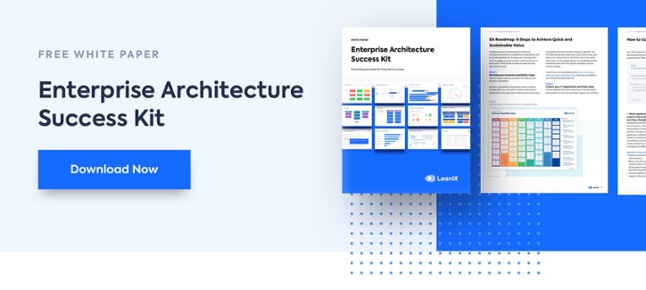
In our 6 blog series about "How to succeed at Enterprise Architecture", we will be talking about the top 6 questions every CIO has for their Enterprise Architects and of course, the answers to these.
Remember that you can always download our free EA Success Kit to get an in-depth view of this topic.
Your CIO wants to know what EA can do for him, sometimes he might not be clear on what value EA is providing. But you can demonstrate to him that transparency achieved through EA can answer some of his most pressing questions.
What applications matter most to the business and how are they changing?
EA can provide the answers to the questions relating to the organization’s application portfolio. From providing an analysis of the status quo that will allow decisions on what applications to invest in and which ones to divest based on reliable data to how well Business Capabilities are supported by technology. And you can play out different scenarios overtime to make sure that your IT is aligned with business strategy
Benefits for the CIO:
- Reduce cost through application rationalization
- Reduce risk through a better understanding of the application landscape’s functional and technical risk profile
- Increase agility through better support of business demands
What are our critical technology dependencies and how can we optimize business data management?
With EA your CIO can achieve a transparent overview of all dependencies between applications and which data is used wherein the business. From knowing where each data object is used to uncovering possible data manipulation conflicts and possible points of failure due to a large number of interfaces.
Benefits for the CIO:
- Reduce cost through data and interface consolidation opportunities
- Reduce risk through better data management, additional securing of highly interdependent applications
- Increase agility through the faster start of integration projects
What are our technology risks?
Your CIO wants to know about the risks in your organization’s IT landscape and how to keep it safe. He needs to have transparency on important IT components and the potential risk they entail. From knowing which IT components are redundant and which applications are at risk because of that to how the application portfolio adheres to security standards.
Benefits for the CIO:
- Reduce cost through standardization and reduction of redundancy
- Reduce risk through an understanding of the impact and compliance to technology lifecycle management
- Increase agility through supporting business capabilities quickly using defined standards and reusable patterns
Where’s our data and how is it used?
Your CIO wants to know what data is used in the business and whether sensitive data is adequately protected. EA can provide him with the answers about the use of data objects and their business relevancy as well as ensure data consistency across the portfolio. From being able to provide information on which user group uses which data to which data support which business capability: your EA tool can provide the answer.
Benefits for the CIO:
- Reduce costs through reduction of redundant data maintenance
- Reduce risk through improved understanding of data qualifications and their impact
- Increase agility through information alignment and re-use according to business needs
Who are our vendors and how are they managed?
The CIO will always be interested in who the organization’s vendors are and whether there is any potential to rationalize costs. From being able to tell who the providers are and how much is spent with each of them to the potential impact on users if one is changed: manage all this information with the help of your EA tool.
Benefits for the CIO:
- Reduce costs through supplier rationalization
- Reduce risk by avoiding dependency on a single vendor
- Increase agility by optimizing the service portfolio for better service levels
How much are we spending on IT?
Your CIO wants to know what the IT budget is spent on to ensure that the investments are in line with strategic priorities. You can provide the answers from the cost of a single application to costs by business capability, user group, provider, project, or IT component.
Benefits for the CIO:
- Reduce cost through improved investment decisions regarding suppliers, applications, and IT components
- Reduce risk by improved project and investment decisions
- Increase agility by the improved speed in investment and project planning and execution




